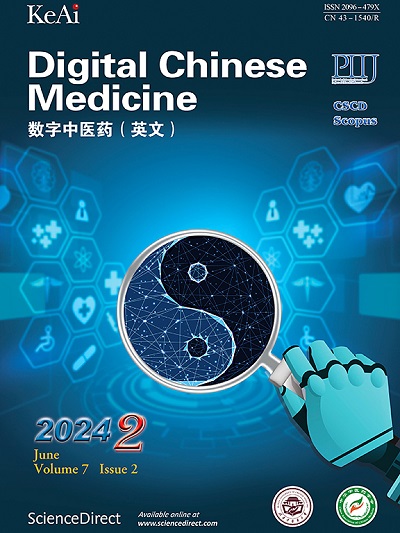Evidence and acupoint combinations in acupuncture for functional dyspepsia: an overview of systematic review and data mining study
Q3 Medicine
引用次数: 0
Abstract
Objective
To evaluate the methodological quality of papers that performed meta-analyzed and systematically reviewed acupoint selections for the treatment of functional dyspepsia (FD) and to identify the ideal acupoint combinations for FD.
Methods
Chinese databases including China National Knowledge Infrastructure (CNKI), China Science and Technology Journal Database (VIP), China Biology Medicine (CBM), and Wanfang Database, as well as English databases including PubMed, Embase, and Cochrane Library were searched to retrieve papers about meta-analysis and systematic literature reviews on acupuncture for FD. The time span for the paper retrieval was set from the foundation of the databases to April 30, 2022. The Veritas scores of the papers based on their publication year, study type, Assessment of Multiple Systematic Reviews 2 (AMSTAR2), Preferred Reporting Items for Systematic Reviews and Meta-Analyses (PRISMA), heterogeneity, and publication bias were rated to assess the methodological quality of the included studies. Then, randomized controlled trials (RCTs) were extracted from those meta-analysis papers or systematic literature reviews for analyzing acupoints frequency, meridian frequency, and association rules with the use of R software (V 4.3.1).
Results
Eight meta-analysis papers were included in the study after screening. The mean Veritas scores of the papers based on publication year, type of study, AMSTAR2, PRISMA, heterogeneity, and publication bias were 4.50, 8.00, 4.63, 4.63, 4.50, and 6.13, respectively. The analysis of the scores revealed insufficiencies in the reviews pertaining to the methodology, comprehension of the research strategy, detailed list of excluded studies, sources of funding, assessment of potential bias risks impact on meta-analysis results in each study, explanation of heterogeneity, and identification of potential conflicts of interest. Furthermore, a total of 85 RCTs were obtained from the eight meta-analysis papers involving 85 acupuncture prescriptions and 67 acupoints for subsequent data mining. The most commonly used meridian was Stomach meridian of Foot-Yangming (ST). Zusanli (ST36), Neiguan (PC6), Zhongwan (CV12), Taichong (LR3), Tianshu (ST25), Gongsun (SP4), Weishu (BL21), Pishu (BL20), Neiting (ST44), and Yinlingquan (SP9) topped the list of frequently selected acupoints. Additionally, a total of 28 association rules were identified, including 10 second-order, 15 third-order, and 3 fourth-order association rules. The top-ranking association rules in each order were “Neiguan (PC6) → Zusanli (ST36)” “Zhongwan (CV12) + Neiguan (PC6) → Zusanli (ST36)” and “Zhongwan (CV12) + Taichong (LR3) + Neiguan (PC6) → Zusanli (ST36)”, respectively.
Conclusion
Acupuncture could alleviate the clinical symptoms of FD. However, the quality of methodology applied in the meta-analysis papers on the subject needs to be improved. Through data mining, a combination of Neiguan (PC6), Zusanli (ST36), Zhongwan (CV12), and Taichong (LR3) was identified as an essential acupoint combination for the treatment of FD.
针灸治疗功能性消化不良的证据与腧穴组合:系统回顾与数据挖掘研究综述
目的评价对功能性消化不良(FD)治疗的穴位选择进行meta分析和系统回顾的论文的方法学质量,并确定FD的理想穴位组合。方法检索中国知网(CNKI)、中国科技期刊库(VIP)、中国生物医学(CBM)、万方数据库等中文数据库和PubMed、Embase、Cochrane Library等英文数据库,检索有关针灸治疗FD的meta分析和系统文献综述。论文检索的时间跨度从数据库建立到2022年4月30日。根据论文的发表年份、研究类型、多系统评价评估2 (AMSTAR2)、系统评价和荟萃分析首选报告项目(PRISMA)、异质性和发表偏倚对论文的Veritas评分进行评级,以评估纳入研究的方法学质量。然后,从meta分析论文或系统文献综述中提取随机对照试验(RCTs),使用R软件(v4.3.1)分析穴位频率、经络频率和关联规则。结果筛选后纳入meta分析论文8篇。基于发表年份、研究类型、AMSTAR2、PRISMA、异质性和发表偏倚的论文Veritas平均得分分别为4.50、8.00、4.63、4.63、4.50和6.13。对评分的分析显示,在方法、对研究策略的理解、排除研究的详细列表、资金来源、对每项研究的meta分析结果的潜在偏倚风险评估、异质性的解释和潜在利益冲突的识别等方面,综述存在不足。此外,从8篇荟萃分析论文中共获得85个随机对照试验,涉及85个针灸处方和67个穴位,用于后续数据挖掘。最常用的经络是足阳明胃经。足三里(ST36)、内关(PC6)、中脘(CV12)、太冲(LR3)、天枢(ST25)、公孙(SP4)、胃俞(BL21)、脾俞(BL20)、内亭(ST44)、隐灵泉(SP9)是最常被选择的穴位。此外,共确定了28条关联规则,其中二阶关联规则10条,三阶关联规则15条,四阶关联规则3条。各排序前位的关联规则分别为“内关(PC6)→祖三里(ST36)”“中湾(CV12) +内关(PC6)→祖三里(ST36)”和“中湾(CV12) +太中(LR3) +内关(PC6)→祖三里(ST36)”。结论针刺可缓解FD的临床症状。然而,关于该主题的元分析论文中应用的方法质量需要改进。通过数据挖掘,确定内关穴(PC6)、足三里穴(ST36)、中脘穴(CV12)、太中穴(LR3)联合为治疗FD的必备穴组。
本文章由计算机程序翻译,如有差异,请以英文原文为准。
求助全文
约1分钟内获得全文
求助全文
来源期刊

Digital Chinese Medicine
Medicine-Complementary and Alternative Medicine
CiteScore
1.80
自引率
0.00%
发文量
126
审稿时长
63 days
期刊介绍:
 求助内容:
求助内容: 应助结果提醒方式:
应助结果提醒方式:


